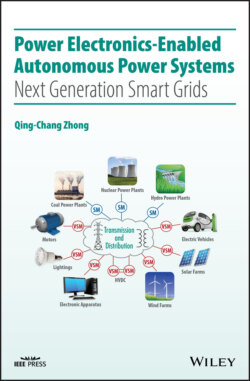Читать книгу Power Electronics-Enabled Autonomous Power Systems - Qing-Chang Zhong - Страница 12
Foreword
ОглавлениеWhen I first met and interviewed Qing‐Chang Zhong at the Illinois Institute of Technology in Chicago, I already knew a lot about the innovative synchronous converter technologies he'd invented to harmonize future power grids. Qing‐Chang's invention is a game changer for the grid. It is the sort of breakthrough – like the touch screen in smart phones – that helps to push an industry from one era to the next.
What I learned about that day, and on ensuing visits between our families, was Qing‐Chang's towering ambition, keen intelligence, and vision for humanity. He has intimate knowledge of the complexity of generating consistent and affordable power to the masses, and the necessity to get this invention into everyday use in time to save the planet.
This book is a comprehensive guide to Qing‐Chang's path‐breaking thinking and work over the last two decades for next‐generation smart grids. It explores the theoretical foundations of his skilled engineering and offers case studies of their application. The book offers a technical solution to implement the lateral power envisioned by futurist Jeremy Rifkin that underpins the Third Industrial Revolution.
Qing‐Chang's goal is to help develop an electrical supply and distribution network that gives more access to various supplies and loads with more influence in its management and operation and advance global energy freedom for billions of people with access to low‐cost clean energy.
Qing‐Chang envisions a near future of complete, 100% generation from distributed energy sources to achieve what he calls “synchronized and democratized (SYNDEM) smart grid.” This unifies and harmonizes distributed energy resources and loads with a common law of synchronization. As a result, his work is designed to promote local resiliency, avoid wide‐area blackouts, and secure the grid from terrorist attacks.
Qing‐Chang's SYNDEM grid architecture, in effect, is an essential tool for achieving one of the most technically challenging industrial transformations in history. The architecture eases stress on contemporary electric transmission grids as coal, nuclear, and gas‐fired centralized generating plants give way to thousands of decentralized and distributed renewable energy stations being installed offshore, in fields, and on ridges and rooftops all over the world. It does so by automatically sensing and instantly reacting to fluctuations in electricity production, demand, and voltage across the grid. That's a real trick for an electrical supply industry diversifying its generating sources so rapidly.
A warm, earnest, accomplished engineer who's studied and taught at prestigious universities on three continents, Qing‐Chang is sincere about his goal. You'll see that in this book's straightforward prose. The development of his autonomous synchronized smart grid speeds our evolution to cleaner energy sources. It is as essential to human progress as the often‐punishing switch from sailing schooners and wood, to steamships and coal. What Qing‐Chang describes is a pathway and state‐of‐the‐art tools that will make our transition to low‐carbon power much more reliable and cleaner, and far less disruptive and expensive.
I've spent four decades reporting on access and demand for energy for the New York Times, the Los Angeles Times, National Geographic, ProPublica, Energy News Network, and other prominent news organizations. My work on six continents is defined by the ability to discover vital trends in energy, science, the environment, and economics, elevate them to national and global attention, and prompt action.
I reported on the Three Mile Island nuclear accident in 1979. A decade later I led a team of New York Times reporters that uncovered the decrepit and dangerous conditions inside America's nuclear weapons manufacturing plants spread across 12 states.
I was among the first journalists to reveal how water scarcity in China's Yellow River Basin was harming the country's energy sector, affecting harvests, and weakening the Chinese economy. That reporting compelled the Chinese Central Government to warn about the impending barrier to development in its 2012 five‐year plan, and to propose solutions. In 2014 the US and China agreed to limit their carbon emissions. The US–China climate agreement includes six provisions. Two of them focused on the confrontation between rising energy demand and declining freshwater reserves. The agreement also was the diplomatic breakthrough that led to the Paris Climate Accord in December 2015.
In other words, I recognize how urgency inspires innovation. Researchers, engineers, professors, students, policy makers, regulatory and legislative organizations will benefit from this book, which thoroughly explores Qing‐Chang's theoretical framework and technologies to make it much easier to develop decentralized and clean sources of electrical energy. As he says, “in this way, we can work together to save the planet before it is too late.”
Keith Schneider
New York Times correspondent since 1982
